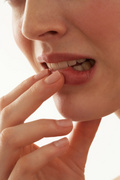 Photo: Getty Images
Photo: Getty Images
All women experience some vaginal discharge. It’s normal.
Vaginal and cervical glands produce small amounts of fluid that flows from the vagina taking out old cells. Normal discharge cleans and moistens the vagina, and helps prevent and fight infections. The amount of discharge is different for everyone. Some women have a little now and then. Others have it every day.
Normal vaginal discharge varies in texture and color. It can be somewhat thin, sticky and elastic or thick and gooey. It should be clear, white or off-white in color and not smell bad. It's important to keep an eye out for any changes. Changes in vaginal discharge’s color or smell may, or may not, be a sign of a vaginal infection.
Anything that interferes with the vagina’s normal environment can alter discharge. Things like menstrual cycles, emotional stress, pregnancy, medications, sexual excitement, breastfeeding, ovulation and diet can change the color or texture of vaginal discharge. Douches, feminine hygiene products, perfumed or deodorant soaps or diabetes can also lead to vaginal infections.
If the amount, color and/or consistency of discharge changes, it may indicate a vaginal infection. It may become green, yellow, or gray; look foamy or like cottage cheese and have a bad odor. Any itching, swelling, redness or the presence of blood when it’s not during a period, could mean an infection.
The most common vaginal infection is bacterial vaginosis (BV). BV may cause heavier than usual discharge. The fluids may become foamy or frothy and grayish in color and have an unpleasant, fishy odor.
Vaginal yeast infections are also very common. Yeast infections can cause discharge to become very white and thick, resembling cottage cheese. A yeast infection usually doesn’t cause a strong odor, but may bring severe itching and burning.
Some infections, like gonorrhea, are transmitted via sex. Gonorrhea causes a yellowish discharge and a burning sensation during urination. Chlamydia brings dense and white, cottage cheese-looking discharge. It’s mostly odorless but can include a burning feeling or pain.
Trichomoniasis is another sexually transmitted disease. Discharge may become grayish or yellow-green, thicker and have a musty, stale odor. It often causes vaginal itching and pain during urination and intercourse.
Many doctors don’t recommend douches to get rid of vaginal discharge. Their chemicals can upset the natural balance of organisms in your body and lead to infection.
It's important to see a doctor if you have any symptoms of abnormal vaginal discharge. Medical treatment includes antibiotics, injections and suppositories.
Stacy Lloyd is a writer and video producer in Phoenix, Arizona. A former television news journalist, she covered stories around the world. Currently, she produces corporate and non-profit videos and broadcast programming.




Add a CommentComments
There are no comments yet. Be the first one and get the conversation started!